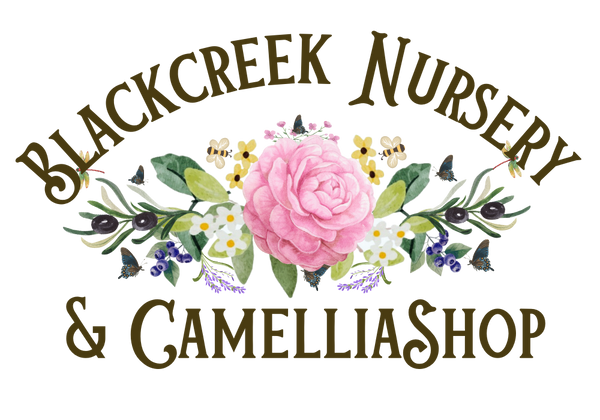Planting Outdoors
Planting outdoors is recommended when and if it is suitable for your area. In warmer regions (climate zone 8 and 9), fall planting is best. For colder climates see below
- Plant in a location suitable for your plant’s needs and your location
- In areas where your plants could get severe freezes, plant under an evergreen tree or next to a wall so that they will be protected from winter winds
- In milder regions, plant in an area with filtered sun from a tree or other protected structure.
- Some varieties can tolerate full sun, but you must know which ones and you should be prepared to give the plant plenty of water and heavy mulch.
Don’t plant too deep.
Piling large amounts of soil on top of the root surface will suffocate your plant. Make sure your soil drains well and into the root mass and does not run off. Avoid locations that remain wet or that do not drain well.
Amend clay soils or very sandy soils with compost for dry soils and with a soil conditioner for soils that are wet or hold moisture.
Mulch plants well to not only keep moisture in, but also to provide excellent humus as the mulch breaks down.
Creating a small burm will help camellias overcome problems with the current soil when it doesn't drain properly. See diagram.

Growing Camellias In Containers
Growing in Camellias in containers is easy. Choose a well draining pot, put rocks in the bottom for extra drainage. Use a very well draining soil that doesn’t retain a lot of water. Fertilize regularly! Repot or root prune when the roots fill the pot.
Fertilizing
- We highly suggest using Hollytone™ & Milorganite™ or any other organic fertilizer for best results.
- Liquid feed applied at regular intervals according to package directions works well for small and large plants but only if it is done regularly. Once a season on using a liquid food is not enough. You eat regularly, so do your plants.
- Avoid Camellia-Azalea food or timed release fertilizer on any plant younger than 3 years old to avoid injury.
- Do not apply any fertilizer that is not specifically listed for acid loving plants or camellias.
Soil pH
Camellias prefer a soil pH of 5.5 to 6.5 for best results and to maintain optimum health. If you are not sure what type of soil you are growing in, whether in the ground or in the container, then have it checked.
Damage, growth problems and nutrient deficiencies can occur in plants that are growing in soils with a pH balance.
Garden soil pH probe testers are not always accurate. Chemical tests are more accurate. You can contact your county extension office for information on soil samples.
Watering
Water when the plant needs it – when it approaches dryness. Water with pure water and avoid additives such as water softeners and water that contains high concentrations of salt.
Insects, Pests & Diseases
Tea Scale, mites and some leaf eating insects can be found munching on your Camellias. Most of these can be controlled with the use of insecticides, oil sprays or soaps. Diseases are few, but root rot (from incorrect soils) leaf blights (leaf browning tips and margins) can occur in certain situations where environmental factors permit the development. All of these problems can be controlled first by proper care and controlling the factors that create the problems.
Treat Camellias for Scale, Mites and Aphids with a horticultural oil spray. All Seasons Oil or Neem Oil works wonders for Camellias and wont harm them, the environment or beneficial insects.
For effective control of most insects, spray until they are under control, then spray three times a year with oil - Spring, summer & fall. Only spray on days when the temperatures are above 50°F and below 90°F to prevent plant damage.
See Our Camellia Catalog!

